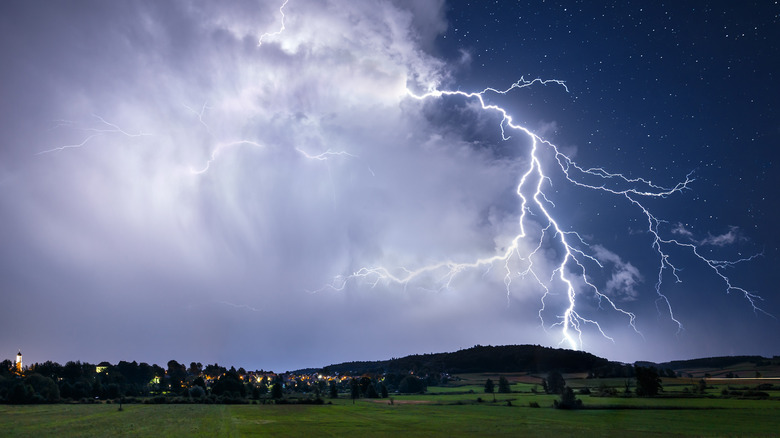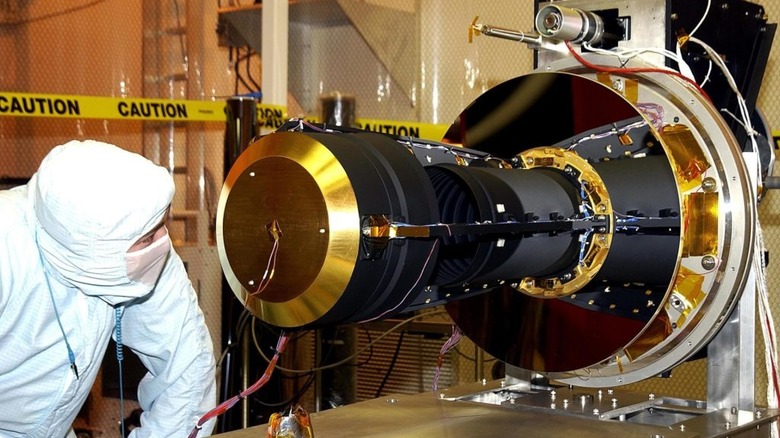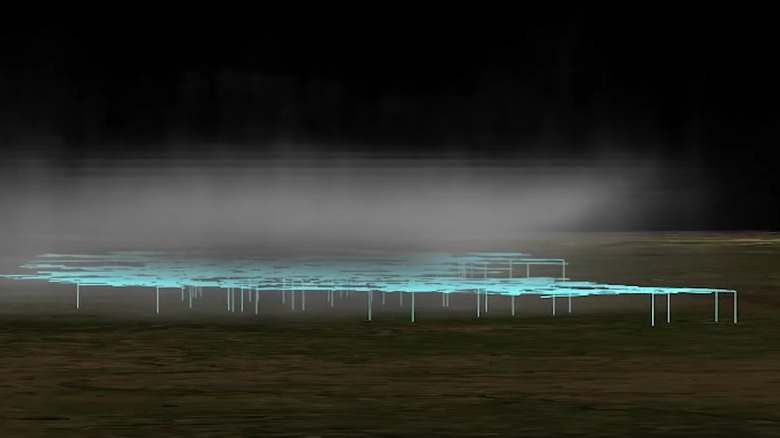The Record-Breaking Lightning Strike That Crossed An Unbelievable Distance
The bright flash of lightning and its accompanying boom of thunder are so grand that the phenomenon has indelibly etched its mark into songs, stories, and religious traditions. Perhaps part of what makes the phenomenon so impactful is its incomprehensible size. As a charge of lightning streaks across a backdrop of dark storm clouds, the lack of landmarks with which to gauge its scale prohibits us from appreciating the distances traveled by its many arcing branches.
In reality, lightning comes in a wide range of lengths and intensities. According to the United States National Weather Service, the average length of a lightning strike is between 2 and 10 miles. That's the horizontal length of the bolt's "cloud-to-ground channel," which doesn't factor in the sum-total length of its many branches and forks. Yet, although seemingly complex, lightning is simply a large-scale example of the discharge of static electricity. You can even make your own lightning in a bottle at home as a cool experiment, and the small charge from such a DIY project is no different from the brilliant light show on display during a thunderstorm.
On the other end of the spectrum, there have been some unbelievably long-reaching lightning strikes, and meteorological instruments have only recently reached the level of sophistication required to measure the extremely large specimens. Thanks to advancements in satellite technology, scientists have recently confirmed a new record-holder for the longest lightning ever. The winner is a 2017 bolt of plasma that flashed across 515 miles of the United States — but the meteorologists involved in the discovery are convinced that the record won't stand for long.
New lightning detectors mean new record-breakers
The thing about the current record–holder for the longest lightning strike is that it's almost certainly not the longest bolt to have ever occurred on Earth — it's just the longest strike to ever be recorded. In fact, the bolt occurred on October 22, 2017, but it wasn't officially confirmed until 2025, when the event was described in a paper published by the World Meteorological Organization. The incredible reach of the 515-mile lightning bolt was detected by NOAA's Geostationary Lightning Mapper (GLM), a satellite-based instrument that captures data in the infrared spectrum. It's a sophisticated piece of tech, which may explain why the record took over seven years to confirm.
The GLM was launched in 2016. In little time, the instrument began recording new record-breaking lightning strikes. For instance, in 2020, the GLM detected a 477-mile-long lightning strike across the Great Plains, which held the length record until the 2017 Texas-to-Kansas strike was later analyzed and confirmed to be the true champion. While the GLM is mostly used as a continuous eye-in-the-sky for real-time meteorological observation, scientists were able to compile its data from 2017 to create a 3D model of the seven-second "megaflash."
The GLM's massive geographical scope of detection is the key to its achievements. Previous lightning detectors were land-based, and they mostly worked in tandem to piece together the picture of a lightning event. Such ground detectors are simple tools for meteorologists, yet they're accurate for detecting events within their lines of sight. The longest lightning bolt ever detected by land-based instruments was a 200-mile strike recorded in Oklahoma in 2007. However, from its mount on the GOES-R satellite, the GLM can direct its single optical detector to measure lightning activity in most of the western hemisphere.
The physics of a megaflash lightning strike
As most people have seen, lightning is composed of an interconnected web of branching arms rather than a single zig-zagging line of light. Thus, when crowning record holders, scientists simplify the definition by recording the horizontal distance covered by a lightning strike's electrical web of arcing arms. A very large lightning strike may touch down onto the earth in multiple cloud-to-ground strikes, nearly simultaneously. Such "megaflashes" require specific conditions to emerge on such a large scale.
Lightning is the result of a charge differential between two clouds (intra-cloud lightning) or a cloud and the ground (cloud-to-ground lightning). The collisions of ice and water particles within a storm cloud can tear electrons free, generating an electromagnetic charge. When a pocket of air separates two differently-charged clouds (or a charged cloud from the ground), the free electrons may reach a high enough level to discharge along pathways of least resistance.
The weather of grasslands is characterized by severe storms, since the vast flat landscape is free of tall features that would otherwise break up storm clouds. This allows the charge differential between the cloud and the ground to remain mostly uniform across the entire expanse of the flat terrain. Consequently, most of the record-breaking megaflashes have occurred in the Great Plains of the United States, and scientists expect future record-holders to emerge from the same geographical region. Indeed, lightning can strike the same place twice.


